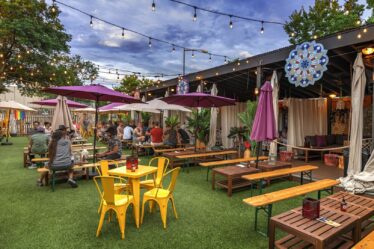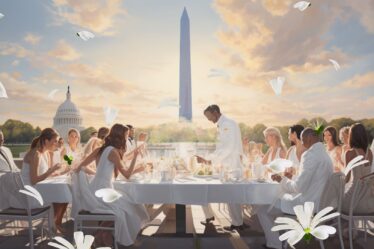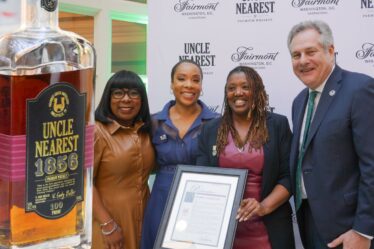
Washington, DC, isn’t just about politics; it’s a treasure trove of history and stunning classical architecture that you can experience firsthand! This city offers more than just a tour of monuments; it invites you to stay and dine in historical places. From the Riggs Hotel’s grandeur to Ocean Prime’s culinary delights, and I’ll mention the National Museum of Women in the Arts, The Library of Congress, and Union Station for good measure. Here’s your guide to the best historical hotels and restaurants in Washington, DC.
Start your historical journey at the Riggs Hotel. Once a bank (Riggs National), this hotel has a downstairs vault turned into a London-imported bar! Built in 1891 in the Richardsonian Romanesque style, the Riggs National Bank was known as the “Bank of Presidents” as it handled the personal finances of many U.S. presidents and embassies. Presidents including Martin Van Buren, John Tyler, Abraham Lincoln, Ulysses S. Grant, Dwight D. Eisenhower, and Richard Nixon all banked here. Imagine enjoying a cocktail where money once was counted.
Next door, treat yourself to a meal at Ocean Prime. It’s not just a seafood place; it’s a spot where every bite tells a story of the sea. Constructed in 1922, the Colorado Building was designed by architect George S. Townsend. This site is significant as the former headquarters of the District of Columbia Suffrage Association and is included on the Women’s Suffrage in Washington DC Tour.
For a slice of French history in DC, head to the Newly Opened La Boucherie. This restaurant, located in a historic building that once served as the headquarters for the Federal-American National Bank, offers more than just food. Designed by architect Alfred C. Bossom in 1925, the bank building has an unusual plan with the banking room on a raised main floor and retail space at street level.
After a luxurious meal, stroll over to Joe’s Seafood. This isn’t just a restaurant; it’s a landmark where each meal feels like a page from a history book. The D.C. location is housed in the original Union Trust Bank building, and diners can still see much of the 1907 structure on display, including intricate masonry, marble columns, and stonework preserved as an homage to Washington’s history.
Feeling royal? Check into the Sofitel Hotel. Initially constructed in 1887 as the “Shoreham Hotel” by Levi P. Morgan, the United States Vice President, its architecture will transport you to Europe without leaving the country. Designed by the renowned architectural firm Herbert, Pirsson & Company in the Classical Revival style, the Shoreham Hotel was envisioned as a beautiful boutique hotel investment opportunity.
Then, there’s the Apple Store, surprisingly located in the historic Carnegie Library. Donated to the public by entrepreneur Andrew Carnegie and dedicated in 1903, the library was designed by the New York firm of Ackerman & Ross in the Beaux-Arts style. It was the first Carnegie Library in Washington, D.C., and the District’s first desegregated public building. Here, technology meets history most elegantly.
Visit Succotash for a unique blend of Southern and Asian cuisines. This restaurant offers a stunning combination of modern chic and historical elegance, housed in the Equitable Bank Building’s 1912 banking hall.
History blends with contemporary comfort at The Line Hotel. Built-in 1912 as the First Church of Christ, Scientist in Adams Morgan, this converted church is a must-stay for those seeking a unique experience.
A visit to DC wouldn’t be complete without mentioning the Willard Hotel. Just steps from the White House, it’s where many presidents have stayed. Imagine sleeping in the same hotel as Abraham Lincoln! Henry Willard, a former chief steward, founded the current hotel in 1847 by leasing and merging six buildings into Willard’s Hotel, and after purchasing it from Ogle Tayloe in 1864, a payment dispute led to a Supreme Court decision mandating payment in gold coin.
Nearby, the Hotel Washington opened in 1918 and was designed by Carrère and Hastings. It also offers luxury and history, with views that overlook epic events. Try Fireclay at Hotel Washington, which has a lineup of small plates and larger, shareable items prepared over an open fire, emphasizing seasonality and flavor.
Hotel Monaco celebrates both art and history. Located inside the neoclassical General Post Office building, a National Historic Landmark constructed in 1839, Kimpton Hotel Monaco DC was the first all-marble building in Washington and patterned after the Roman Temple of Jupiter.
Dine at Iron Gate, one of DC’s oldest buildings, for a romantic evening under the stars. Initially opened in 1923 as the Iron Gate Inn, this restaurant is a legacy of the tea house craze of the 1910s and 1920s, where customers sought refuge or escape from urban life in quaint, rustic settings.
The Waldorf Astoria is a beacon of luxury and historical significance. Originally the Old Post Office Building, listed on the National Register of Historic Places, it was built in 1899 with a distinctive Richardsonian Romanesque style. The building has served various functions throughout history, from a post office to a federal office space. It underwent significant renovations and transformations, including its recent conversion into the Trump International Hotel, which was later sold and reopened as the Waldorf Astoria Washington DC.
Constructed in 1892-94 for German-American brewer Christian Heurich, the Heurich House exemplifies Richardsonian Romanesque architecture in Washington, DC, featuring early technological advancements and intricate decorations by German-American artisans. Today, it operates as the Heurich House Museum, offering innovative programs that connect historical insights with modern local businesses and artisans, highlighted by “1921,” a Biergarten showcasing local craft beers and supporting educational and small business development initiatives, open Wednesdays to Fridays from 4-8 pm and Saturdays from 12-8 pm.
One more! The National Gallery of Art, located on the National Mall in Washington, D.C., was established in 1937 through a joint resolution of the United States Congress, reflecting a unique collaboration between public authorities and private interests. Andrew W. Mellon, a prominent financier and art collector, contributed a significant art collection and funding for the museum’s construction, enriching the nation’s cultural landscape. Inside, the Garden Café within the museum offers a delightful spot for visitors to enjoy lunch or weekend brunch (10:00 a.m.–4:30 p.m.), featuring a variety of fresh pastries and convenient grab-and-go items, enhancing the overall experience of art and leisure.
So there you have it! From banks turned into chic hotels and restaurants to historic landmarks reimagined for modern use, Washington, DC, offers a unique blend of history and modern amenities.
Book a room or a table at these historical gems and make your next trip to Washington, DC, unforgettable. Explore these historic places and create your own experiences that will become part of DC’s rich tapestry. Remember, Washington, DC, is more than just a city; it’s a living museum waiting to be explored. Don’t miss out!
Join my newsletter! Joining the Washington Lobbyist newsletter keeps you informed on the latest in DC's food and travel scene, exclusive hotel events, and insider hospitality insights that you won't find anywhere else.
Powered by EmailOctopus


